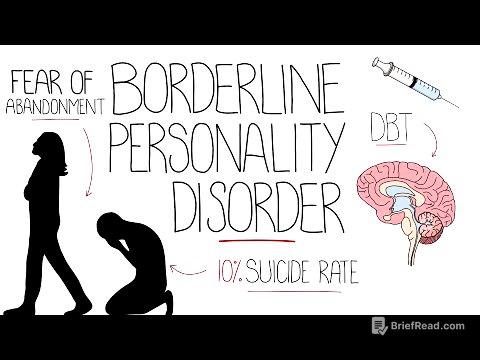TLDR;
This video provides a simplified overview of Dialectical Behavior Therapy (DBT), focusing on its core principles and practical applications. It highlights the importance of understanding behavior, practicing mindfulness, regulating emotions, and improving interpersonal effectiveness. The video also discusses key DBT assumptions, treatment priorities, and stages, offering actionable strategies for therapists and counselors.
- DBT is effective for clients with high emotional vulnerability.
- DBT skills include mindfulness, distress tolerance, emotion regulation, and interpersonal effectiveness.
- Key principles involve dialectical theory, understanding action and reaction, and integrating multiple perspectives.
Introduction to DBT [0:29]
The presentation introduces Dialectical Behavior Therapy (DBT) as a practical approach, particularly for those not yet ready for formal DBT practice but interested in its skills. It is based on the book "Dialectical Behavior Therapy Made Simple," which presents DBT skills in an accessible format. This approach is especially useful for clients who do not exhibit the high levels of self-injury seen in Marsha Linehan's original DBT work. The presenter prefers to start with newer techniques on less acute clients to ensure effectiveness.
Core Components of DBT [1:58]
The core components of DBT include understanding behavior, mindfulness, reducing emotional reactivity, developing distress tolerance skills, and regulating emotions. It emphasizes the importance of not just eliminating negative emotions but also increasing positive ones. A key aspect is helping clients become more effective in relationships, addressing past traumas and invalidation that may contribute to their emotional difficulties.
Understanding Clients with High Emotional Vulnerability [5:04]
DBT is designed for clients with high emotional vulnerability, who react intensely to situations and take longer to recover. These individuals often struggle with emotional regulation due to a lack of emotional vocabulary and validation during their upbringing. They may express emotions ineffectively, leading to feelings of isolation and maladaptive coping mechanisms.
Dialectical Theory in DBT [7:46]
Dialectical theory, a foundation of DBT, emphasizes the interconnectedness of actions and reactions. Examples include addiction, where initial drug use leads to a dopamine rush, followed by the brain reducing its sensitivity, creating a cycle of increased use. Similarly, anger pushes people away, leading to isolation and increased stress. Depression can lead to staying in bed, disrupting circadian rhythms and intensifying feelings of helplessness. Positive social interactions, conversely, encourage further positive engagement.
Reality and Perception in DBT [11:32]
Reality is in constant flux, and perceptions change over time. Clients are encouraged to examine how their perceptions evolve after a crisis. The approach involves integrating emotional and rational minds to find a balanced compromise. The truth is seen as evolving, found by integrating multiple perspectives and tolerating seemingly opposite ideas.
Skills Training and Individual Sessions [16:47]
DBT uses skills training groups in a neutral environment to teach basic skills, which are then applied in individual sessions during more heated situations. Core mindfulness increases self-awareness of thoughts, feelings, and urges, helping clients understand and interrupt negative behavior patterns. This approach helps clients recognize that emotions don't always require immediate action.
Core Mindfulness and Interpersonal Effectiveness [18:58]
Core mindfulness helps clients understand that emotions don't always require immediate action. Interpersonal effectiveness skills help individuals assert their feelings without demanding agreement from others. Clients learn to identify relationship goals and develop skills for effective communication, negotiation, and compromise.
Emotion Regulation Skills [20:44]
Emotion regulation skills involve labeling and communicating feeling states effectively. Understanding the function of emotions, such as anger and fear, is crucial; these emotions signal a need for action. Activities like charades can help clients explore and understand different emotions. Recognizing the connection between thoughts, feelings, and behaviors is key to breaking negative chains.
Distress Tolerance and DBT Assumptions [24:23]
Distress tolerance skills are survival skills that offer alternatives to self-harm during overwhelming emotions. Key assumptions in DBT include that clients are doing their best with the tools they have and want to improve. Therapy aims to provide more effective tools and support for change. Clients must recognize that even if they didn't cause their problems, they need to address them.
Key Principles in DBT [27:24]
Clients should strive to act skillfully in all areas of their lives, generalizing learned skills. Clients cannot fail in therapy if they are trying their best; any failures indicate a need to re-evaluate the therapeutic approach. Treatment priorities include addressing suicidal or self-harming behaviors, behaviors that interfere with therapy, and suicidal ideation.
Integrating DBT Skills and Treatment Stages [30:34]
Mindfulness, emotion regulation, interpersonal effectiveness, and distress tolerance should be integrated into all treatment stages. Initial steps involve ensuring safety and becoming mindful of triggers. True DBT involves phone consultations and skills groups, but this presentation focuses on skills applicable in traditional therapy.
Treatment Priorities and Stages [33:03]
Treatment begins by addressing self-harm behaviors, then moves to behaviors interfering with therapy, and finally to suicidal ideation. Maintaining treatment gains and addressing client goals are also important. Stages of treatment include attaining basic capacities, reducing traumatic stress, and increasing self-respect.
The B in DBT: Behavior Analysis [37:13]
Analyzing behavior in DBT involves understanding positive and negative reinforcement. For example, substance use may provide positive reinforcement by inducing feelings of euphoria and negative reinforcement by numbing pain. Punishment involves the consequences of using, such as financial loss or guilt. Intermittent reinforcement, like a child's persistence for candy, can shape behavior. Modeling effective coping and emotion regulation is also crucial.
Understanding Vulnerabilities and Triggers [40:05]
Vulnerabilities, such as tiredness or stress, increase the likelihood of a fight-or-flight response. Backward chaining helps clients understand the sequence of events leading to an outburst. Triggers remind individuals of past situations where behaviors were either rewarded or punished. Increasing positive triggers and decreasing negative ones is important.
Shaping and Mindfulness in DBT [43:18]
Shaping involves rewarding successive approximations of desired behaviors, such as gradually improving anger management. For addiction or self-harm, initial steps involve engaging in secondary coping behaviors before progressing to mindfulness and evaluating the situation. Mindfulness involves developing in-the-moment awareness of emotional, mental, and physical states, recognizing their interconnection.
Emotional Reactivity and Distress Tolerance [46:49]
Reducing emotional reactivity involves treating physical illnesses, eating nutritiously, avoiding mood-altering substances, getting enough sleep, and exercising. Building positive experiences and being mindful of current emotions are also important. Distress tolerance techniques include engaging in activities, contributing to others, comparing oneself to others coping well, using opposite emotions, pushing away distressing thoughts, and focusing on intense sensations.
Understanding and Managing Emotions [49:01]
Clients need to understand their emotions, decreasing negative ones and increasing positive ones. Identifying and eliminating unnecessary irritants is crucial. Positive activities can counteract negative emotions. Interpersonal effectiveness involves teaching assertiveness, distress tolerance, emotion identification, and communication.
Interpersonal Effectiveness and Dialectical Theory [50:13]
Interpersonal effectiveness requires understanding one's own needs and the needs of others. Dialectical theory encourages taking multiple perspectives in interpersonal situations. The "DEAR MAN" acronym outlines steps for effective communication: describe, express, assert, reinforce, be mindful, and appear confident, while being willing to negotiate.
Conclusion: DBT as a Tool for Emotional Awareness [52:29]
DBT is a valuable tool for increasing emotional awareness, identifying thoughts, feelings, and urges, and developing self-awareness. It helps clients understand their vulnerabilities and the mind-body connection. DBT provides a framework for teaching skills groups that benefit clients with emotional difficulties.









